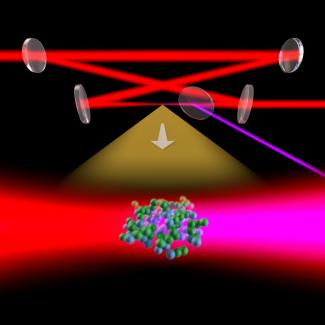The Ye Group recently investigated what first appeared to be a “bug” in an experiment and made an unexpected discovery about a new way to generate high-harmonic light using molecular gases rather than gases of noble atoms.
Graduate student Craig Benko and his colleagues in the Ye group were studying the interaction of light from an extreme ultraviolet (XUV) frequency comb with molecules of nitrous oxide, or laughing gas (N2O), when they noticed unusual perturbations in the laser spectrum. At first, the researchers thought the moving spectrum was some kind of bug they’d need to fix. But, like many unexpected observations in science, the ‘bug’ turned out to be a sign the group had discovered something new and unexpected.
Benko, research associates Linqiang Hua and François Labaye, former research associate Tom Allison (now Assistant Professor of Physics and Chemistry at Stony Brook University), and Fellow Jun Ye decided to figure out exactly what was happening in their experiment. They considered whether the bug might have something to do with their new XUV frequency comb laser.
Frequency comb lasers do not usually have sufficiently powerful pulse peaks to control the behavior of molecules. However, in this experiment, the researchers used an optical cavity to bounce the laser light back and forth multiple times, increasing the laser’s power. With this powerful new, precise ruler of light, they were not only able to observe the mystery of the moving spectrum, but also investigate it.
The researchers used the powerful laser to send two trains of pulses inside the cavity. They observed that the laser field of the first pulse “kicked” the N2O molecules, which made the stick-shaped molecules line up parallel to each other. In other words, they became aligned with respect to the laser field. As the first laser pulse passed, the molecules started to tumble in unison, then periodically realigned as time went on. The frequency comb laser in the cavity made it possible to align the molecules more than 100 million times per second (as compared to 1000 times per second in previous experiments.)
As the molecules were tumbling, the researchers aimed a second, much more intense pulse at the molecules, sometimes when they were aligned and sometimes when they were not. Either way, the more intense pulse initiated high-harmonic generation. High-harmonic generation occurs when laser-stimulated atoms or molecules emit light of higher harmonics of the fundamental frequency of the driving laser.
However, the second, more intense laser pulses were also partly responsible for the spectral perturbations! The “bug” in the system turned out to be an energy exchange between the molecules and the laser. The energy exchange caused the laser spectrum to move around. By studying this process, the researchers observed that the time delay between the two laser pulses determined whether the molecules stole energy from the laser pulse, or gave some back.
By adjusting the timing of the two pulses, the researchers discovered they had the makings of an excellent tool for investigating the physics of the N2O molecules used for the high-harmonic generation! Consequently, the researchers plan to use two XUV combs working in tandem (a process described in Invisible Rulers of Light) to probe the behavior of the N2O molecules during high-harmonic generation.
As it turns out, the “buggy” experiment has opened the door to studies of high-harmonic generation in molecules and comparisons of this process with the more traditional high-harmonic generation using noble gas atoms such as xenon. Since xenon atoms are spheres, a comparison of their high-harmonic generation with high-harmonic generation with stick-like N2O molecules should yield some interesting new physics. Stay tuned. ––Julie Phillips



 The Physics Frontiers Centers (PFC) program supports university-based centers and institutes where the collective efforts of a larger group of individuals can enable transformational advances in the most promising research areas. The program is designed to foster major breakthroughs at the intellectual frontiers of physics by providing needed resources such as combinations of talents, skills, disciplines, and/or specialized infrastructure, not usually available to individual investigators or small groups, in an environment in which the collective efforts of the larger group can be shown to be seminal to promoting significant progress in the science and the education of students. PFCs also include creative, substantive activities aimed at enhancing education, broadening participation of traditionally underrepresented groups, and outreach to the scientific community and general public.
The Physics Frontiers Centers (PFC) program supports university-based centers and institutes where the collective efforts of a larger group of individuals can enable transformational advances in the most promising research areas. The program is designed to foster major breakthroughs at the intellectual frontiers of physics by providing needed resources such as combinations of talents, skills, disciplines, and/or specialized infrastructure, not usually available to individual investigators or small groups, in an environment in which the collective efforts of the larger group can be shown to be seminal to promoting significant progress in the science and the education of students. PFCs also include creative, substantive activities aimed at enhancing education, broadening participation of traditionally underrepresented groups, and outreach to the scientific community and general public.